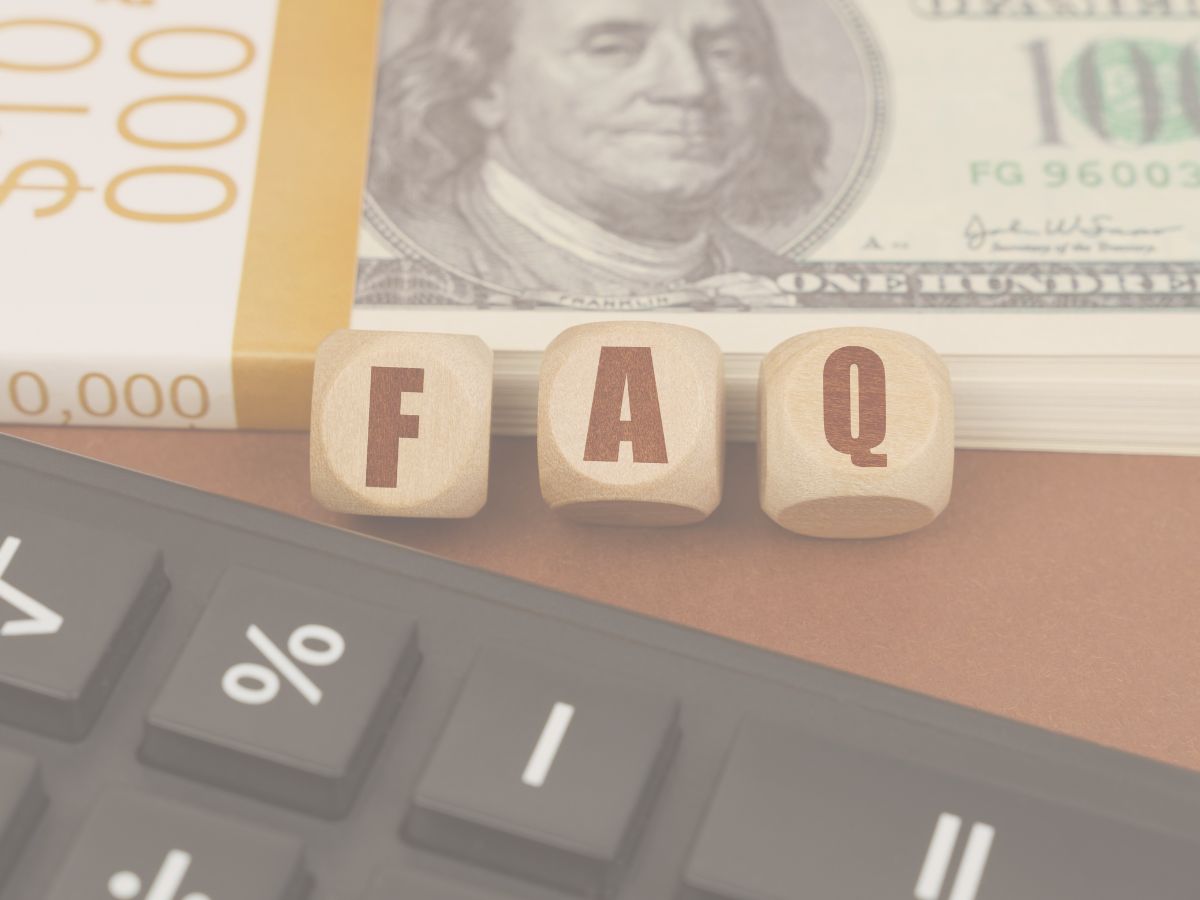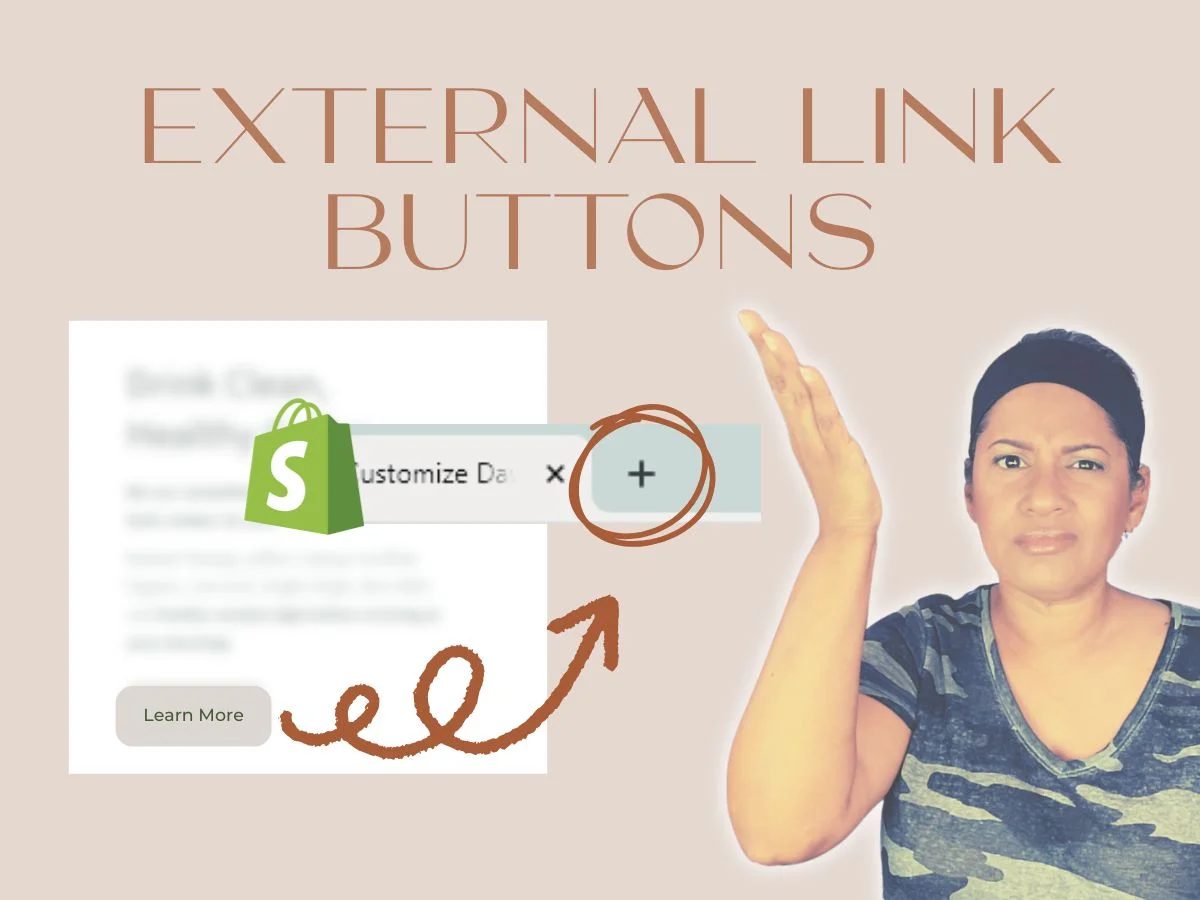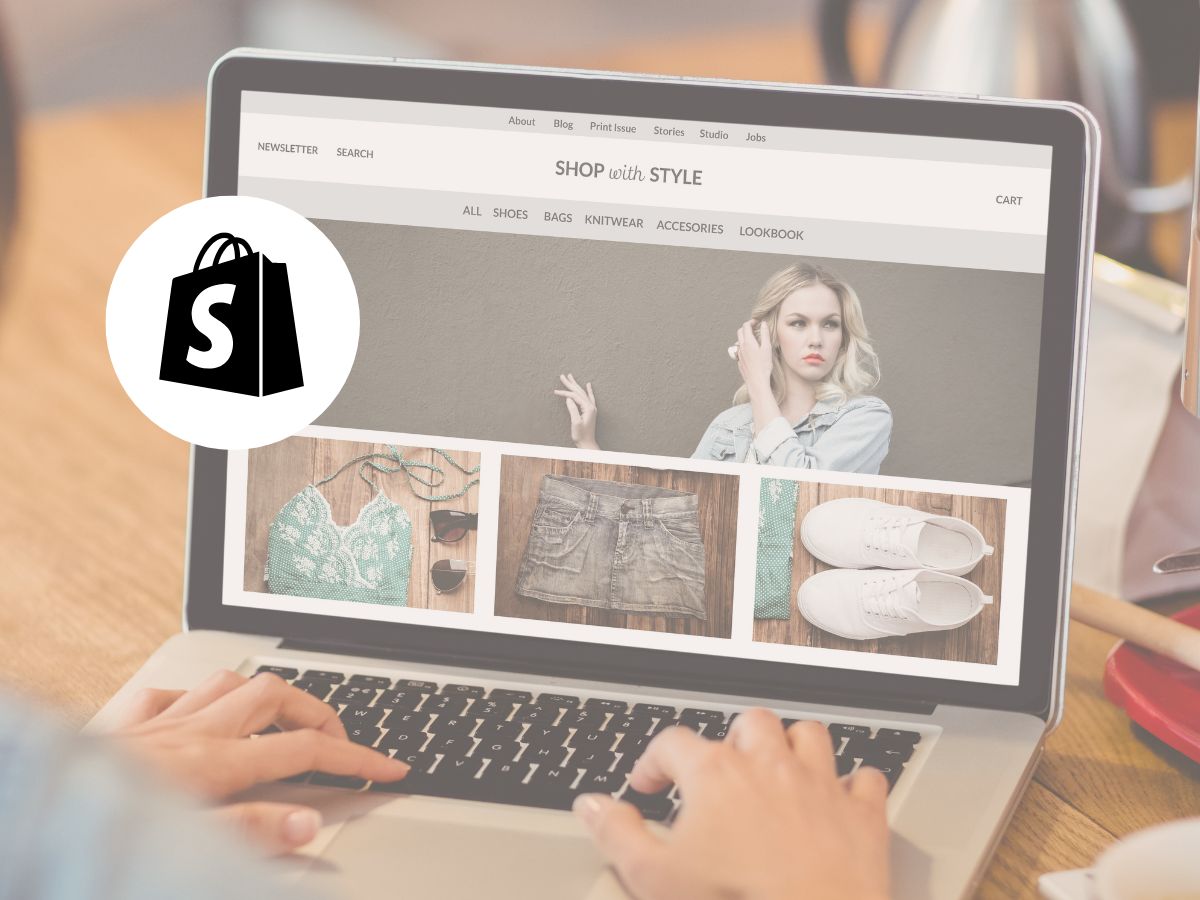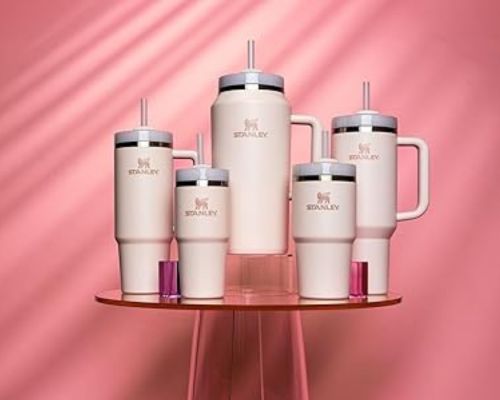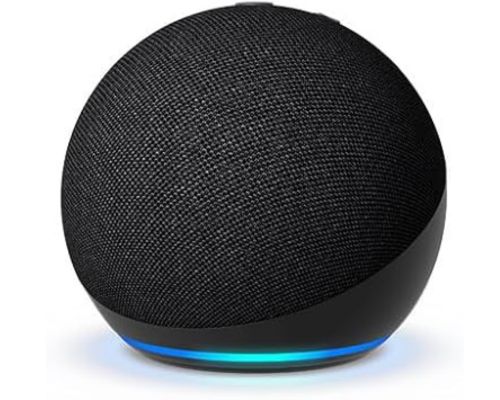When a potential customer is just one unanswered question away from clicking away, those little FAQ sections on your product pages aren’t just helpful—they’re profit protection! 🛡️
How many times have YOU abandoned a purchase because you couldn’t find an answer to your question? We’ve ALL been there!
But listen up: FAQs aren’t a second chance to write your product description or a dumping ground for details you forgot to include elsewhere. (We’ll get deeper into this misconception soon!)
Today, I’m showing you how to use search intent with strategic FAQ sections that place useful information exactly where your customers need answers!
Never heard of search intent? No worries! It’s simply understanding WHY someone searches online—their real goal behind typing those keywords. Are they researching? Comparing options? Ready to buy? Each intent needs different information at different times.
These focused Q&A areas address specific concerns right at the decision-making moment, helping you:
- Reduce bounce rates (goodbye, one-and-done visitors!)
- Boost conversion rates (hello, sales!)
- Build trust with potential customers
Let’s talk about how these FAQ sections can transform browsers into buyers! 🙌🏽
Difference Between FAQ Sections vs. FAQ Pages
Before we talk about the how-to details, let’s clear up the difference between FAQ sections and FAQ pages. They might seem similar, but they serve different purposes in your e-commerce strategy!
Strategic Differences in Placement and Purpose
FAQ sections are small, targeted Q&A areas placed directly on product pages. They’re like having a customer service associate standing right beside your customer at the exact moment they have a question. These mini-FAQs are context-specific and answer questions related to the particular product the customer is viewing.
FAQ pages, on the other hand, are dedicated, comprehensive pages that address broader questions about your store. They serve as a central knowledge base for your entire shop. These pages typically cover shipping policies, return processes, company information, and other store-wide concerns.
How FAQ Sections Target Specific Intent at Decision Points
What makes FAQ sections so powerful is their strategic placement at critical decision points. When a shopper is looking at a product and thinking “I wonder if this will work for me…” or “What happens if I get an allergic reaction?”—your FAQ is right there with the answer.
These sections directly address the micro-moments of doubt that can kill a sale. By anticipating questions at the exact moment they arise in the customer journey, you’re removing friction from the buying process.
When Dedicated FAQ Pages Make More Sense
While FAQ sections are powerful conversion tools, there are times when a comprehensive FAQ page is a better option:
- For processes that require detailed explanations (like custom orders)
- When providing information that applies across all products
- For support issues that may need in-depth troubleshooting
FAQ pages also help reduce emails, DMs, ect. by providing a searchable resource for common questions, which is especially helpful as your business scales.
Creating a Complementary Strategy Using Both Approaches
The truth is, you don’t have to choose! You can use both approaches in a complementary strategy:
- Use FAQ sections on product pages to address product-specific questions and overcome buying objections in the moment
- Create a comprehensive FAQ page for store policies, general information, and complex processes
- Link between them strategically to provide a seamless customer experience
This dual approach ensures customers get the information they need, when they need it, without overwhelming them with too much information at once.
Want to learn about creating a full FAQ page for your store? Check back soon for my complete guide or subscribe to be notified when it’s ready.
Weekly emails for eCommerce shop owners!
Tips, Tricks & Resources to Design, Maintain, and Grow Your eCommerce Store.
Why FAQs on Product Pages Matter
Have you ever noticed how the best sales associates seem to know what you’re going to ask before you even ask it? That’s exactly what FAQ sections do for your online store. They provide proactive answers, to questions they are REALLY asking, right when they need them most.
Here are 4 reasons why FAQs are so powerful for your e-commerce business:
#1 Reduces Friction
Every question a potential customer has is a potential obstacle to purchase. When shoppers can’t find answers to their questions, they face what we call “friction” in the buying process.
FAQ sections eliminate this friction by anticipating and addressing concerns before they become roadblocks. Instead of forcing customers to hunt for information or, worse, leave your site to search elsewhere, you’re providing answers right on the product page.
For example, if you’re a new clothing brand customers may wonder about sizing for your clothing items, an FAQ that addresses “How do your sizes run compared to [insert a similar known brand]?” can remove that obstacle.
#2 Improve Conversion Rates
Confused buyers DON’T buy! When you address real concerns directly on your product pages, you’re actively removing reasons for customers NOT to buy. In other words, customers no longer have to leave the product page to get the information they need to make a confident purchase decision.
#3 Boost User Experience
Today’s online shoppers expect convenience and clarity. FAQ sections contribute to a smoother, more intuitive shopping experience by providing information exactly where and when it’s needed.
This improved user experience has benefits beyond the immediate sale:
- Reduced support tickets since questions are already answered
- Lower bounce rates as customers find what they need without leaving
- Higher likelihood of return visits since they had a positive experience
#4 Reinforces Trust and Authority
When you anticipate REAL customer questions accurately, you demonstrate that you understand their needs and concerns. This builds confidence in your brand and products.
Thoughtfully curated FAQ sections signal to your customers that:
- You’re transparent about your products
- You value their time by making information easily accessible
- You understand there needs
This trust-building aspect is especially important for new businesses or high-priced items where customers may be naturally more cautious before purchasing.
FAQs Isn’t a Cop-Out for Weak Product Pages
Let’s clear something up right quick…an FAQ section is NOT a second chance to write your product description. It’s not a place to stick leftover details you didn’t know where to put.
Your product description, details, and images must do the heavy lifting. That means clearly explaining key details like:
- Burn time and scent notes (for candles)
- Ingredient list and skin type compatibility (for skincare)
- Fabric type and fit (for apparel)
- Compatibility and specs (for tech products)
If someone has to dig through your FAQ just to find out what a product does you’ve already lost them.
The FAQ section is where you answer next-level questions—the ones that pop up after someone has read everything else but still has one doubt holding them back.
Think of it like this:
✅ Thoughtful FAQ question:
“Will this candle fill a large open-plan living room, or is it more of a desk scent?”
🚫 Lazy FAQ question:
“What is the burn time?”
(That belongs in the product description. Period.)
Pro tip: Before adding any questions to your FAQ, ask yourself:
Is this helping someone decide, or just making up for missing info?
If it’s the latter, put it where it belongs—in the main product copy.
Now that we’ve cleared up what FAQ sections AREN’T (lazy product descriptions), let’s talk about what they ARE: powerful tools for addressing specific customer search intent.
Remember when we talked about understanding why people search online? If you haven’t read my E-commerce Guide to Search Intent, the basic idea is that people search with different goals in mind. And guess what? Your FAQ sections can be strategically designed to address all these different intents!
Connecting FAQs to the Four Types of Search Intent
Your FAQ section should speak directly to what your shoppers are already thinking—but to do that, you need to understand why they’re searching. That’s where search intent comes in.
There are four main types of intent which I cover in detail in the E-commerce Guide to Search Intent: Informational, Navigational, Commercial, and Transactional. Strategically aligning your FAQ content to each one can significantly improve user experience and guide shoppers towards a purchase. To illustrate this, here’s a breakdown with examples across different niches, showcasing the types of questions users ask based on their intent and how you can provide thoughtful answers:
| Intent Type / eCommerce Niche Example Questions (User’s Perspective) Thoughtful Answer (Addressing Intent & Providing Value) |
|---|
| 📰 Informational / Home Fitness QUESTION: “I’m new to [type of exercise], is the [Machine Name] easy to use for someone just starting out?” ANSWER: “Great question! Yes, the [Machine Name] is designed with beginners in mind. It features [mention specific beginner-friendly features like adjustable resistance levels, clear digital display, or included starter workouts]. We also have a library of beginner tutorials on our website [link].” |
| 📰 Informational / Skincare QUESTION: “My skin is [specific concern, e.g., oily and acne-prone], will the [Product Name] likely cause breakouts or irritation?” ANSWER: “That’s a common concern! Our [Product Name] is formulated to be non-comedogenic, meaning it’s less likely to clog pores. It also contains [mention specific ingredients known to be beneficial for acne-prone skin, e.g., salicylic acid or tea tree oil]. However, as with any new product, we recommend doing a patch test on a small area first.” |
| 🌐 Navigational / Home Decor QUESTION: “The Lamp looks beautiful in your showroom photos. Is it to scale?” ANSWER: “Yes, the Lamp [Name] shown in our showroom photos is to scale. We do not use AI or mockups for our images!” |
| 🔍 Commercial / Clothing QUESTION: “I typically wear a size [your usual size] at Zara/H&M. How does your sizing for the [Garment Name] run? Should I order the same size or size up/down?” ANSWER: “Thanks for providing that context! Our [Garment Name] tends to run [explain sizing, e.g., slightly smaller/larger/true to size] compared to Zara/H&M. We recommend checking our detailed size chart [link] which includes specific measurements. Many customers with similar sizing in those brands have found [suggested size] to be the best fit.” |
| 💸 Transactional / Specialty Food QUESTION: “I’m interested in the [Specific Coffee Bean Blend]. If I order a larger quantity to save, but find it’s not to my taste, can I return the unopened portion?” ANSWER: “That’s a thoughtful question for trying a new blend! While we take pride in the quality of our beans, we understand taste is subjective. For unopened portions of larger quantity orders like the [Specific Coffee Bean Blend], you can request a return for store credit within [Number] days of receipt. Please contact our customer support team at [phone number or email address] with your order details, and they’ll assist you with the process. This allows you to explore new flavors with a little extra peace of mind.” |
I hope you can now see how an FAQ section isn’t just a list of random Q&As. By thinking about the different types of search intent your potential customers might have, you can proactively address their needs and concerns directly on your product pages and throughout your website.
This strategic approach helps guide them towards making a purchase decision by providing the right information at the right time.
Sooo… I hope you can apply this framework to your own product niche and start brainstorming the real questions your customers are asking at each stage of their journey.
How to Strategically Add FAQs on Your Product Pages
Here’s are a few concise action steps to putting FAQs into action:
- Identify Key Questions: Understand your customers’ pain points and the common questions they have before purchasing a specific product. Analyze customer service inquiries, reviews, and think about potential hesitations.
- Choose Strategic Placement: Integrate these mini-FAQs directly on the product page where they are most relevant. In Shopify, consider placing them in the section that follows the product description.
- Write Concise and Helpful Answers: Keep your answers brief, direct, and focused on providing the necessary information to overcome objections and build confidence.
- Use Clear Formatting: Use bullet points, bold text, and short paragraphs to make the FAQs easy to scan and digest quickly.
- General Shopify Implementation: Depending on your Shopify Theme, use the FAQ or Collapsible content sections to build your FAQs section.
- If your theme doesn’t offer a specific FAQ section or you just want more customization options, consider using section snippets from Qwiqode, which offer flexible layouts like Tabbed Content or Info Accordion that are ideal for organizing your questions and answers. I am an affiliate of Qwiqode and use them on many projects, use the code
Betsy10to receive 10% off.
- If your theme doesn’t offer a specific FAQ section or you just want more customization options, consider using section snippets from Qwiqode, which offer flexible layouts like Tabbed Content or Info Accordion that are ideal for organizing your questions and answers. I am an affiliate of Qwiqode and use them on many projects, use the code


Effective FAQs Section Example
A great example of strategic FAQs in action can be found on the “Our Place” website regarding their product, “Always Pan 2.0”.
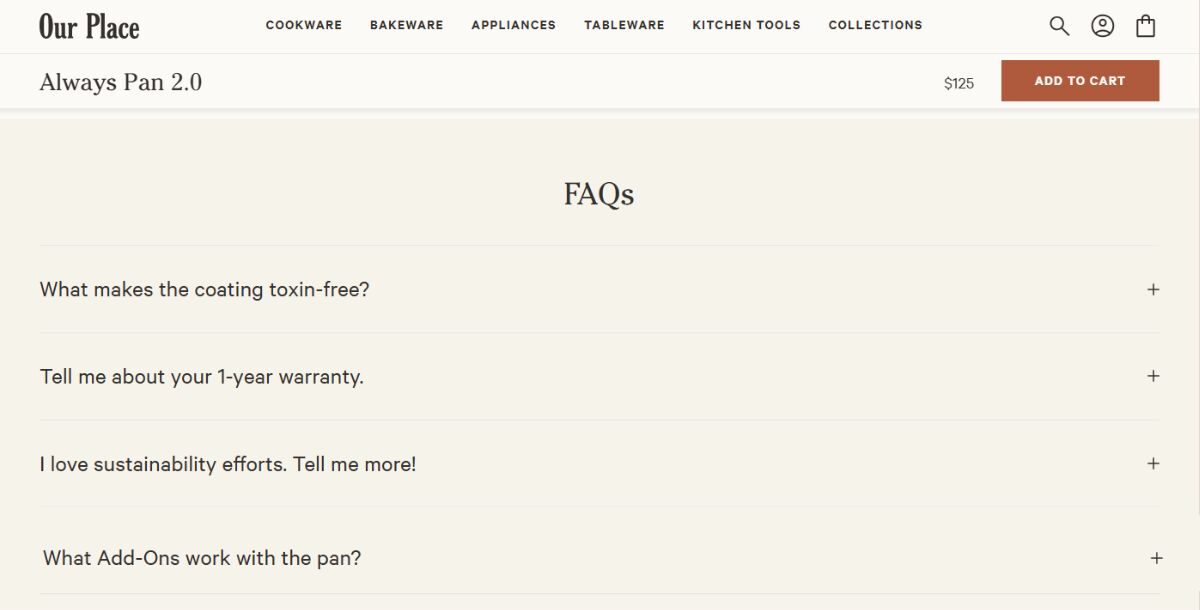
Let’s do a quick and to-the-point analysis of the effectiveness of their FAQs based on what’s visible. In my opinion, it effectively:
- Addresses Pre-Purchase Concerns: The visible questions directly tackle common considerations like safety (“toxin-free coating”), risk (“warranty”), values (“sustainability”), and functionality (“add-ons”). This proactively answers questions that could prevent a sale.
- Thinking Like the Customer: Questions like “Tell me about…” and “I love…” are framed from the customer’s perspective, showing they’re thinking about what the buyer wants to know.
- Clear Organization: Using collapsible sections under a clear “FAQs” heading makes the information easily scannable and accessible without overwhelming the user.
- Potentially Addresses Multiple Intents: Even the short questions hint at catering to informational (understanding features, values), and transactional (warranty as a risk reducer) intent.
- Builds Trust: By addressing potential concerns directly and transparently, they build trust with potential buyers.
What we can learn: Our Place uses a well-placed, user-focused FAQ section that addresses pre-purchase questions, making it likely effective in reducing customer hesitation and potentially increasing conversions without needing to contact support. It’s a concise and strategic implementation.
The Exception That Proves The Rule
When Your Product Page Is So Good You Might Not Need FAQs 🤯
While I’m advocating for strategic FAQ sections, it’s worth looking at an example like that on thehoneypot.co to understand when an Q&A section is not necessary.

This HoneyPot product page for their Normal Foaming Wash excel because:
- They anticipate customer questions within the main product description instead of separating them into an FAQ
- They incorporate a marquee and features strip to showcase more details
- They include a clear “How To Use” section and Clinical results
What we can learn: If your product pages already address all potential questions seamlessly within your descriptions, you might not need a separate FAQ section. The key is making sure all customer questions are answered somewhere on the page, regardless of format.
(Screenshot of HoneyPot’s product page)
However, for most e-commerce stores, a dedicated FAQ section creates helpful structure and makes scanning for specific information easier for customers who already know what they’re looking for.
Strategic FAQs are a powerful tool to address immediate customer questions right at the point of purchase, ultimately reducing friction and increasing sales. I encourage you to implement these targeted Q&A sections on your product pages to capture search intent and enhance the buying experience.
We covered a 💩 TON in this post, and I hope it was helpful and eye-opening! If after reading this you’re thinking, “WOW, I don’t want to do THIS work!”, don’t worry – I’ve got you! Reach out today for a consultation, and let’s talk about how I can help you implement strategic FAQs.
Stay tuned for our upcoming guide on creating comprehensive FAQ pages for your website!
